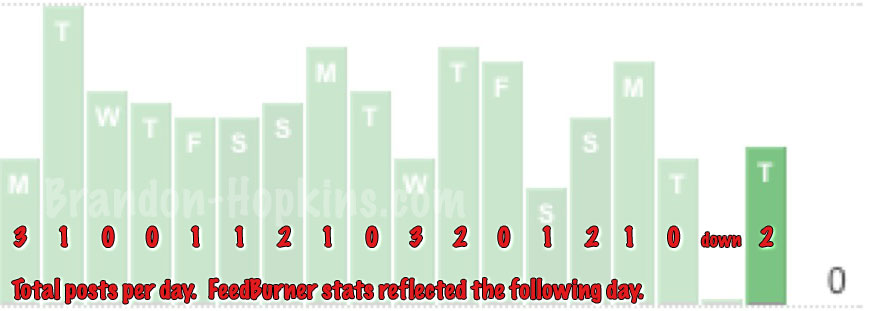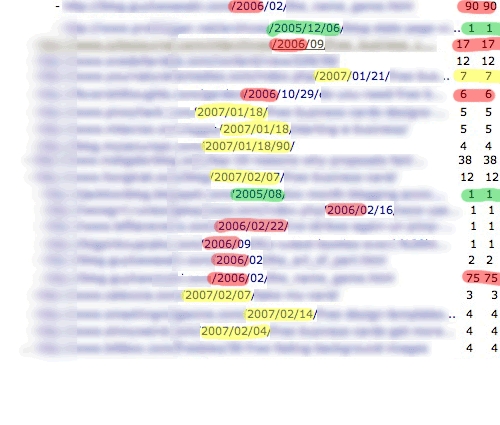How To: Achieve the Perfect Post Frequency
 This is post 3 of 5 in a series called, “5 Tips to Increasing Blog Traffic“.
This is post 3 of 5 in a series called, “5 Tips to Increasing Blog Traffic“.
3. Posting Frequency
In this post we’re going to look at how to post the perfect amount of posts to achieve the optimal “snowball effect“.
For one of my blogs, I try to post 2-4 times per day. Why? This is what my readers want. For another blog, 1 time a day maximum. How do I know this? The stats tell me!
If you don’t have a FeedBurner account, I highly recommend it. It tracks your RSS feed subscribers and gives you some data and more control of your feed without having to learn to code XML.
The picture below represents the last 3 weeks from one of my sites. FeedBurner updates stats daily, so the day after multiple posts should show more subscribers. Also in there is the day my server HDD crashed.
As you can see, when I post 3 posts, my subscribers shoot up. When I post one or two posts, my subscribers stay the same, or go up slightly. This is the data that showed me the optimal amount of posts for this blog. With some more trial and error I might find that my subscribers will be ok with 1 post on the weekends since this is a business-person oriented blog, most of which don’t work during the weekends.
What are the potential downsides for too many posts?
Too Many Posts
I have 9 total sites in my RSS reader (I use the Google personalize start page). Out of these 9 sites, I read every post from 7 of them. The two that I don’t? Digg / Technology and Slashdot. Why do I rarely read these updates? They post like a bazillion posts per day and I can’t keep up. If they were 3 updates per day, I would read all of them, every day. I understand Digg and Slashdot are more news outlets than blogs, but still the point remains.
Too Few Posts
About once a month I remove a feed and add a few feed to my RSS readers, know why? Too few posts per day. Most of the ones that get removed have 1 post every other day, 3-4 posts per week! I want something that is updated daily, atleast daily, preferrably multiple times per day.
The Perfect Posting Amount
So what is the perfect posting amount? The perfect posting amount is like the Perfect Storm. Three factors must come together in perfect harmony, answer these three questions and find the perfect posting amount for your blog:
1. Who are your readers?
Are they professionals? Are they high school students? Stay at home mothers? Obviouslly these three groups would read your blog at very different times.
Professionals – 7:45 a.m. – 8:15 a.m. then 11:45 a.m. – 1:15 p.m. then before the day ends at 4:45 p.m.
High School Students – 3:30 p.m. – Midnight
SAHM – Various times during the day, usually from 8 a.m. to 5 p.m.
2. What do they want to read?
Personally, I don’t care much about your life and what you did last night. I want to get from your blog what I expect to get. If your blog is a SEO blog, give me SEO. If it is about business marketing tips, give me some tips. I do, however, like to hear a personal voice. Shoemoney is great at this. Almost all of his articles are on target with what I expect, even the personal stuff is worth reading because it is all relevant to making money online.
3. How can you keep them?
If you are in my RSS reader, and want to keep me there, post frequently, post on topic, and post engaging headlines. If you are writing about a new tool you created for SEM (search engine marketing) you have multiple title options. “My Newest SEM Tool” or “Check Out My New Tool” or “Free Tool Helps You Move Up SERPS Easily“.
Which of those 3 headlines is most likely to get clicked on? Obviously #3.
So why do you want those RSS subscribers? If people are reading your blog daily, they will spread the word. Only people interested in your target niche will read your blog. They likely have their own blog, and they might post a link to you, they might send an email to their friends, the possibilities are endless, but only if you can capture more RSS subscribers.
If you can post the optimal amount for your blog, learn to comment effectively, a learn how to linkbait, you’re on the way to the top!





Recent Comments